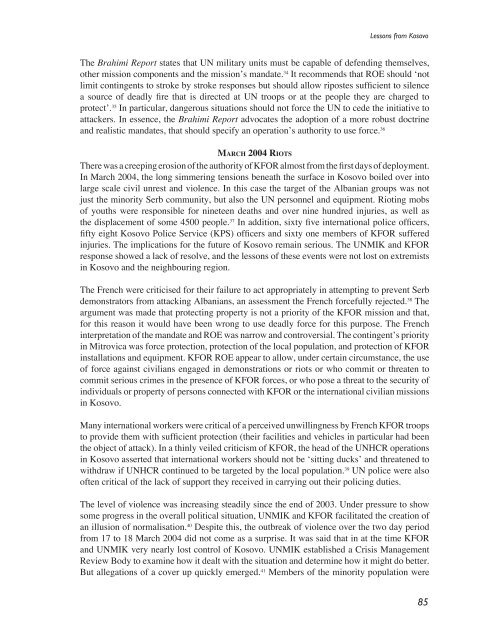Defence Forces Review 2008
Defence Forces Review 2008
Defence Forces Review 2008
You also want an ePaper? Increase the reach of your titles
YUMPU automatically turns print PDFs into web optimized ePapers that Google loves.
Lessons from Kosovo<br />
The Brahimi Report states that UN military units must be capable of defending themselves,<br />
other mission components and the mission’s mandate. 34 It recommends that ROE should ‘not<br />
limit contingents to stroke by stroke responses but should allow ripostes sufficient to silence<br />
a source of deadly fire that is directed at UN troops or at the people they are charged to<br />
protect’. 35 In particular, dangerous situations should not force the UN to cede the initiative to<br />
attackers. In essence, the Brahimi Report advocates the adoption of a more robust doctrine<br />
and realistic mandates, that should specify an operation’s authority to use force. 36<br />
Ma r c h 2004 Ri o t s<br />
There was a creeping erosion of the authority of KFOR almost from the first days of deployment.<br />
In March 2004, the long simmering tensions beneath the surface in Kosovo boiled over into<br />
large scale civil unrest and violence. In this case the target of the Albanian groups was not<br />
just the minority Serb community, but also the UN personnel and equipment. Rioting mobs<br />
of youths were responsible for nineteen deaths and over nine hundred injuries, as well as<br />
the displacement of some 4500 people. 37 In addition, sixty five international police officers,<br />
fifty eight Kosovo Police Service (KPS) officers and sixty one members of KFOR suffered<br />
injuries. The implications for the future of Kosovo remain serious. The UNMIK and KFOR<br />
response showed a lack of resolve, and the lessons of these events were not lost on extremists<br />
in Kosovo and the neighbouring region.<br />
The French were criticised for their failure to act appropriately in attempting to prevent Serb<br />
demonstrators from attacking Albanians, an assessment the French forcefully rejected. 38 The<br />
argument was made that protecting property is not a priority of the KFOR mission and that,<br />
for this reason it would have been wrong to use deadly force for this purpose. The French<br />
interpretation of the mandate and ROE was narrow and controversial. The contingent’s priority<br />
in Mitrovica was force protection, protection of the local population, and protection of KFOR<br />
installations and equipment. KFOR ROE appear to allow, under certain circumstance, the use<br />
of force against civilians engaged in demonstrations or riots or who commit or threaten to<br />
commit serious crimes in the presence of KFOR forces, or who pose a threat to the security of<br />
individuals or property of persons connected with KFOR or the international civilian missions<br />
in Kosovo.<br />
Many international workers were critical of a perceived unwillingness by French KFOR troops<br />
to provide them with sufficient protection (their facilities and vehicles in particular had been<br />
the object of attack). In a thinly veiled criticism of KFOR, the head of the UNHCR operations<br />
in Kosovo asserted that international workers should not be ‘sitting ducks’ and threatened to<br />
withdraw if UNHCR continued to be targeted by the local population. 39 UN police were also<br />
often critical of the lack of support they received in carrying out their policing duties.<br />
The level of violence was increasing steadily since the end of 2003. Under pressure to show<br />
some progress in the overall political situation, UNMIK and KFOR facilitated the creation of<br />
an illusion of normalisation. 40 Despite this, the outbreak of violence over the two day period<br />
from 17 to 18 March 2004 did not come as a surprise. It was said that in at the time KFOR<br />
and UNMIK very nearly lost control of Kosovo. UNMIK established a Crisis Management<br />
<strong>Review</strong> Body to examine how it dealt with the situation and determine how it might do better.<br />
But allegations of a cover up quickly emerged. 41 Members of the minority population were<br />
85
















